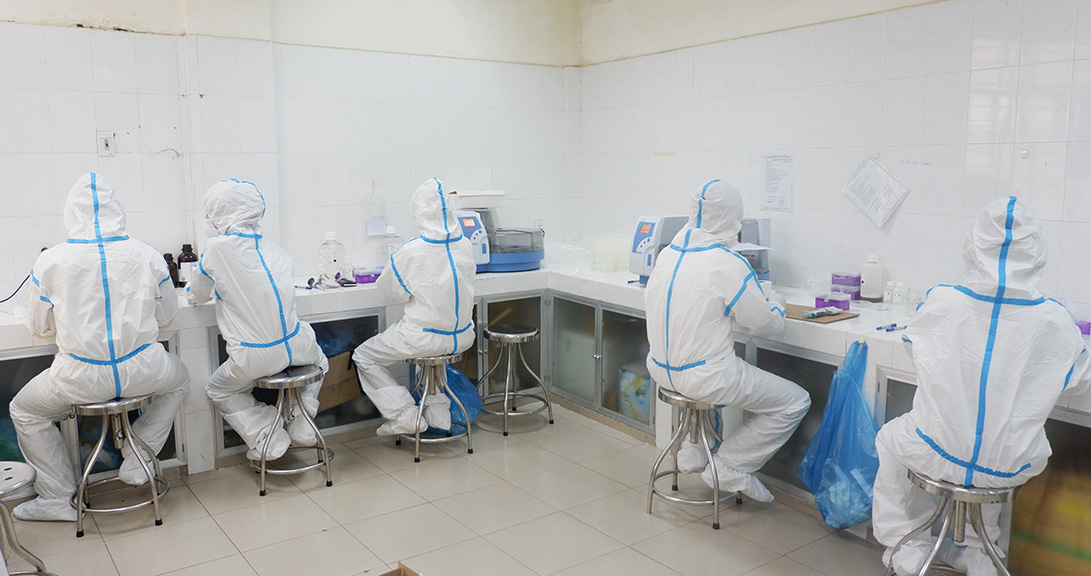As Da Nang grapples with a new wave of COVID-19 cases, lab technicians at the Da Nang Center for Disease Control (CDC) are working to extremes to meet the increased testing demand.
The demand for COVID-19 testing in Da Nang has risen to thousands of new inquiries per day accompanied by test samples arriving at local test labs.
The workload that the lab technicians have been given has turned out to be as intense as their colleagues who work directly with patients battling against COVID-19.
As of August 8, the medical department of Da Nang City reported a total of 40,451 clinical samples having been collected since July 25, when the central tourist city recorded Vietnam’s first local transmission of COVID-19 after 99 days.
Since then, 405 cases traced to Da Nang, the country’s outbreak epicenter, have been documented nationwide.
Sleepless nights
Pulled out of bed by an emergency call on the morning of August 3, Dr. Le Thanh Chung, deputy director of Da Nang CDC, rushed to the agency’s headquarters on Phan Chau Trinh Street to inspect the situation.
There were problems with the clinical specimens being delivered, the practitioner on duty reported.
Relying on the glimmering street lights to see, four medical staffers of the sample reception team perused the pages in the report, referencing every single sample to probe the issue.
After 30 minutes of scrutiny and cross-checking by phone with lower-level medical facilities, the staffers let the samples enter the headquarters building, ready to undergo the next processing steps.
Circumstances like these have become a part of the day-to-day routine for Da Nang CDC staff since the city confirmed the resurgence of locally-transmitted COVID-19 cases nearly three weeks ago.
Da Nang CDC has kept its sample reception unit open around the clock for sample submission from lower-level hospitals, due to the fact that sample collecting takes tremendous effort and can extend far after business hours during the pandemic.
Packages may arrive as late as 2:00 am and contain as many as 700 samples.
“We have to take all of them in, capture their information into the system, and ensure smooth operations so no sample would be left uncategorized. Most importantly, we need to be completely precise, as the smallest error would ruin the collective effort of the whole society,” Chung said.
“Fifteen days ago, the screening capacity of Da Nang CDC used to settle at 500-700 samples per day, but now it has been raised tenfold, which goes to show that we have gone all out on this."
Uninterrupted duties
During the first outbreak earlier this year, Da Nang CDC was able to send personnel support to surrounding provinces.
This time around, as the city got caught in the worst COVID-19 outbreak in Vietnam, the medical agency had to call on the Da Nang University of Medical Technology and Pharmacy for professional aid.
To surmount the workload, each of Da Nang CDC’s lab practitioners is taking on three shifts a day.
Lab technician Phan Viet Son said that each sample kept him in suspense just as much as it did with the sample owner, as his hands swiftly handled clinical specimens.
He had been quartering himself at the lab for ten consecutive days to share the line of duty with his colleagues.
His wife is also a medical practitioner working at the Da Nang Oncology Hospital, a COVID-19 treatment center in the city, which leaves them no choice but to send their children back to their grandparents who live in the countryside.
The family only manages to talk to each other on the phone occasionally.
In their working stations, electric lights are left on 24/7. Their perception of night and day gradually blends into each other, their focus set on the slightest beeps signifying progress made by the testing machine.
Each of them carries out their individual tasks with little conversation, all too aware of the difference time can make in this endeavor.
As there are ten times more submissions than usual, the operation requires precision, most importantly, and also productivity, Nguyen Thi Thanh Nhan, head of the laboratory division under Da Nang CDC, explained.
“We try to make use of every spare moment. A new batch of samples is inserted into the machine the moment a previous batch is completed. People cannot take any breaks, so there is no reason for machines to have one,” Nhan jokingly said.
Because the lab technicians have to wear protective coveralls, they find it hard to perform the most basic activities of daily living. Even mealtimes and hygiene activities are forced to wait as they cannot afford to pause work to take off the suits.
Another unit housed in the same building is also working diligently trying to find answers, led by two experts — Assoc. Prof. Dr. Le Thi Quynh Mai, deputy director of the National Institute of Hygiene and Epidemiology (NIHE), and Assoc. Prof. Dr. Nguyen Le Khanh Hang, deputy head of the Division of Viral Disease under the NIHE.
Their COVID-19 test unit is a standing outfit of the Ministry of Health in Da Nang, who will work to provide situational analysis and strategic foresight to uncover the root cause of the outbreak, a vital part in the effort against COVID-19 because it can inform physicians of the optimal treatment and isolation period as well as the discharge point for infected patients.
“Each of us is running our own race, yet we all share the same element of excitement,” Mai said.
Like us on Facebook or follow us on Twitter to get the latest news about Vietnam!




















































